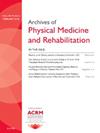Performance-Based Functional Outcomes 12 and 24 Months After Transfemoral Osseointegration in Service Members With Traumatic Unilateral and Bilateral Lower Limb Loss
IF 3.7
2区 医学
Q1 REHABILITATION
Archives of physical medicine and rehabilitation
Pub Date : 2025-10-01
DOI:10.1016/j.apmr.2025.04.021
引用次数: 0
Abstract
Objective
To evaluate functional outcomes at 12 months and 24 months after transfemoral osseointegration (OI) using established performance-based assessments.
Design
Pre-post observational single cohort.
Setting
Military treatment facility.
Participants
Forty-seven (N=47) service members (mean age ± SD, 38±9y) with traumatic unilateral (n=22) and bilateral (n=25) lower limb loss. Before OI, n=2 unilateral and n=7 bilateral were not ambulatory on full-length prostheses.
Interventions
Transfemoral OI (2-stage threaded implant).
Main Outcome Measures
Six-Minute Walk Test (6MWT), timed Up and Go (TUG), 4 Square Step Test (4SST), (Bilateral) Amputee Mobility Predictor ([B]AMP), and Comprehensive High-level Activity Mobility Predictor (CHAMP).
Results
For both unilateral and bilateral cohorts, the median performance-based functional outcomes were similar at 12 months and 24 months after vs before OI: 6MWT (373 and 385 m vs 417 m; p>.31), TUG (9.7 and 9.6s vs 9.8s; p>.53), 4SST (9.5 and 10.6s vs 10.8s; p>.11), and CHAMP (12.6 and 10.6 vs 12.3; p>.44). Median BAMP scores were greater at 12 months (p=.029) and 24 months (p=.014) after vs before OI among the bilateral cohort (30 and 35 vs 16); median AMP scores were similar (p>.10) among the unilateral cohort across time points (39 and 43 vs 40). Among the 9 participants not ambulating with full-length prostheses before OI, 8 became capable of ambulation on full-length prostheses 24 months after OI.
Conclusions
While a lack of improvement in these particular outcomes is not exclusively suboptimal, particularly considering the median scores at baseline reported here generally exceeded those of other cohorts (both before and sometimes even after OI), these findings contrast with previous self-reported improvements in function after OI among service members with traumatic lower limb loss. As such, these data seemingly emphasize the importance of a comprehensive approach with both subjective and objective (multidisciplinary) outcomes to more fully characterize OI, particularly within unique patient populations like young service members with traumatic lower limb loss.
基于性能的功能结果:创伤性单侧和双侧下肢丧失军人经股骨融合后12个月和24个月。
设计:观察前后,单队列设置:军事治疗机构参与者:47名患有外伤性单侧(n=22)和双侧(n=25)下肢丧失的服役人员(年龄=38±9岁)。在成骨不全之前,n=2例单侧和n=7例双侧在全长假体上不能行走。主要观察指标:六分钟步行测试(6MWT)、定时起身和行走(TUG)、四方步测试(4SST)、[双侧]截肢者活动能力预测([B]AMP)、综合高水平活动能力预测(CHAMP)。结果:对于单侧和双侧队列,在成骨不全后12个月和24个月,基于表现的中位功能结局与成骨不全前相似:6MWT(373和385比417m;p>0.31), TUG(9.7和9.6 vs. 9.8;p>0.53), 4SST(9.5和10.6 vs. 10.8;p>0.11), CHAMP(12.6和10.6 vs. 12.3;p > 0.44)。双侧队列中,成骨不全后12个月(p=0.029)和24个月(p=0.014)的中位BAMP评分高于成骨不全前(30和35比16);在不同时间点的单侧队列中,AMP得分中位数相似(p>0.10)(39和43 vs. 40)。在成骨不全之前没有使用全长假体行走的9名参与者中,有8名在成骨不全后24个月能够使用全长假体行走。结论:虽然这些特殊结果缺乏改善并不完全是次优的,特别是考虑到这里报告的基线中位数得分通常超过其他队列(在成骨不全之前,有时甚至在成骨不全之后),这些发现与之前创伤性下肢丧失的服务人员在成骨不全之后自我报告的功能改善形成对比。因此,这些数据似乎强调了综合主观和客观(多学科)结果的重要性,以更充分地表征成骨不全症,特别是在特殊的患者群体中,如创伤性下肢丧失的年轻服役人员。
本文章由计算机程序翻译,如有差异,请以英文原文为准。
求助全文
约1分钟内获得全文
求助全文
来源期刊
CiteScore
6.20
自引率
4.70%
发文量
495
审稿时长
38 days
期刊介绍:
The Archives of Physical Medicine and Rehabilitation publishes original, peer-reviewed research and clinical reports on important trends and developments in physical medicine and rehabilitation and related fields. This international journal brings researchers and clinicians authoritative information on the therapeutic utilization of physical, behavioral and pharmaceutical agents in providing comprehensive care for individuals with chronic illness and disabilities.
Archives began publication in 1920, publishes monthly, and is the official journal of the American Congress of Rehabilitation Medicine. Its papers are cited more often than any other rehabilitation journal.

 求助内容:
求助内容: 应助结果提醒方式:
应助结果提醒方式:


